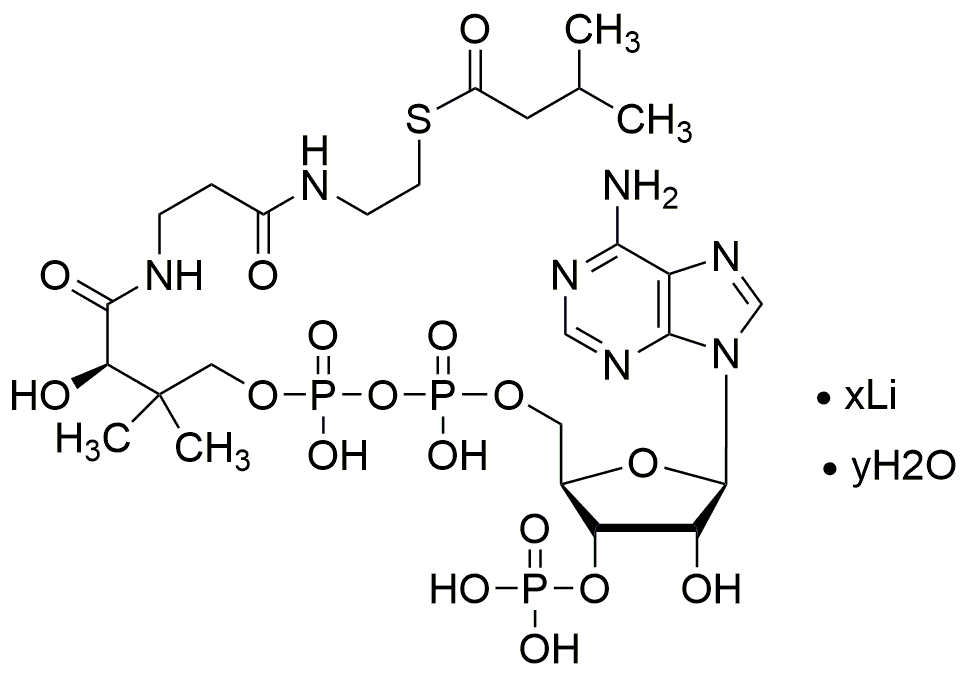Isovaleryl coenzyme A lithium salt hydrate is widely utilized in research focused on:
- Metabolic Studies: This compound plays a crucial role in studying fatty acid metabolism and energy production, making it valuable for researchers investigating metabolic disorders.
- Biochemical Pathways: It serves as a key intermediate in various biochemical pathways, allowing scientists to explore enzymatic reactions and metabolic flux in cellular systems.
- Pharmaceutical Development: The compound is used in the synthesis of pharmaceuticals, particularly in the development of drugs targeting metabolic diseases, providing a pathway for innovative treatments.
- Biotechnology Applications: In biotechnology, it aids in the production of biofuels and biochemicals, enhancing the efficiency of microbial fermentation processes.
- Analytical Chemistry: It is utilized as a standard in analytical methods to quantify metabolic products, ensuring accurate measurements in research and quality control in industries.
General Information
Properties
Safety and Regulations
Applications
Isovaleryl coenzyme A lithium salt hydrate is widely utilized in research focused on:
- Metabolic Studies: This compound plays a crucial role in studying fatty acid metabolism and energy production, making it valuable for researchers investigating metabolic disorders.
- Biochemical Pathways: It serves as a key intermediate in various biochemical pathways, allowing scientists to explore enzymatic reactions and metabolic flux in cellular systems.
- Pharmaceutical Development: The compound is used in the synthesis of pharmaceuticals, particularly in the development of drugs targeting metabolic diseases, providing a pathway for innovative treatments.
- Biotechnology Applications: In biotechnology, it aids in the production of biofuels and biochemicals, enhancing the efficiency of microbial fermentation processes.
- Analytical Chemistry: It is utilized as a standard in analytical methods to quantify metabolic products, ensuring accurate measurements in research and quality control in industries.
Documents
Safety Data Sheets (SDS)
The SDS provides comprehensive safety information on handling, storage, and disposal of the product.
Product Specification (PS)
The PS provides a comprehensive breakdown of the product’s properties, including chemical composition, physical state, purity, and storage requirements. It also details acceptable quality ranges and the product's intended applications.
Certificates of Analysis (COA)
Search for Certificates of Analysis (COA) by entering the products Lot Number. Lot and Batch Numbers can be found on a product’s label following the words ‘Lot’ or ‘Batch’.
Numéro de catalogue
Numéro de lot/série
Certificates Of Origin (COO)
This COO confirms the country where the product was manufactured, and also details the materials and components used in it and whether it is derived from natural, synthetic, or other specific sources. This certificate may be required for customs, trade, and regulatory compliance.
Numéro de catalogue
Numéro de lot/série
Safety Data Sheets (SDS)
The SDS provides comprehensive safety information on handling, storage, and disposal of the product.
DownloadProduct Specification (PS)
The PS provides a comprehensive breakdown of the product’s properties, including chemical composition, physical state, purity, and storage requirements. It also details acceptable quality ranges and the product's intended applications.
DownloadCertificates of Analysis (COA)
Search for Certificates of Analysis (COA) by entering the products Lot Number. Lot and Batch Numbers can be found on a product’s label following the words ‘Lot’ or ‘Batch’.
Numéro de catalogue
Numéro de lot/série
Certificates Of Origin (COO)
This COO confirms the country where the product was manufactured, and also details the materials and components used in it and whether it is derived from natural, synthetic, or other specific sources. This certificate may be required for customs, trade, and regulatory compliance.


